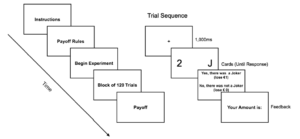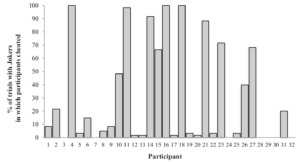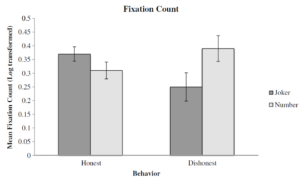Mavis has aged gracefully. With the beneficent smile of the ailurophile she exits the attorney’s office of Smith & Jones after signing her will, which bequeaths her estate to the local cat sanctuary. Mavis leaves behind a crisp $100 bill to pay for Mr. Smith’s services.
A short while later, Mr. Smith discovers that the $100 bill is actually two brand new $100 bills that were tightly stuck together. The discovery throws Mr. Smith into a deep ethical dilemma: Should he tell his partner, Mr. Jones, or not?
Most of us have experienced ethical dilemmas, although outside the realm of lawyers’ jokes, we might have entertained the possibility of calling Mavis and returning the extra $100 to her. (Although…. cats!?)
People generally balance two competing desires when they encounter ethical dilemmas: Their self-interest and their moral standards. We like the idea of “finding” $100 but we also don’t want our partners to think of us as avaricious.
Recent research has generally shown that we resolve such dilemmas by employing a variety of self-deception strategies that enable us to cheat (a little) while retaining our self-perception as being ethical individuals. To strike this balance, people tend to limit the extent to which they indulge in dishonesty for their own benefit. Numerous experiments have shown that when people are given the opportunity to cheat, they will do so, but they do not take full advantage of the opportunity—in consequence, those “mild cheaters” consider themselves to be as honest and moral as other participants who did not have the opportunity to cheat.
But what exactly are the cognitive processes by which people preserve their self-esteem while cheating just a little bit? (Maybe Mr. Jones should get $20?)
A recent article in the Psychonomic Bulletin and Review examined those underlying processes by focusing on the role of attention in cheating. Many global scandals, such as the collapse of Enron, have been linked to the failure of top managers and executives to pay attention to ethical standards.
Researchers Andrea Pittarello, Daphna Motro, Enrico Rubaltelli, and Patrik Pluchino examined the role of attention in cheating using a laboratory task in which participants’ eye movements were recorded. Keeping track of where our eyes are pointing offers a window into our attentional system, as we have noted on this forum repeatedly.
Participants watched a randomly drawn pair of playing cards being presented on the screen in front of them. Cards could be either numbers or “Jokers”, and people had to report whether one of the cards was a Joker or whether both cards were numbers. At least one of the cards on each trial was always a number.
Whenever participants reported that one of the cards was a Joker, they would lose $1 from an initial financial endowment with which they started the experiment. Whenever participants indicated that both cards were numbers, no loss was incurred. The diagram below explains the experimental procedure:

Here is the dilemma: There were so many Jokers in the sequence that a completely honest participant would walk out of the lab with exactly nothing. A maximally cheating participant who never saw a single Joker, by contrast, would earn $60. How many Jokers would you see?
The behavioral results are shown in the figure below for all of the 32 participants individually:

Participants 4, 11, 16, and 18 appear to be partners in the firm of Smith & Jones, whereas participants 3, 7, 24, 28, 29, and 30 were either philosophers of ethics or misunderstood the instructions.
Overall, people cheated on around 30% of all occasions. No one ever made the mistake of indicating the presence of a Joker when there was none, suggesting that the failure to detect a Joker was not just a consequence of bad vision or simple mistakes. (In further confirmation, a second experiment in which there was no incentive to cheat showed that participants could perform the task with 99.5% accuracy).
Pittarello and colleagues were particularly interested in the analysis of eye movements. What did people pay attention to when they cheated? The answer is that they looked at the number rather than the Joker: gaze fixations on the Joker on trials when people cheated (and claimed that no Joker was present) were shorter and fewer in number. The figure below shows the fixation count for trials on which people were honest or cheated:

People avoided looking at information they did not want to see, presumably because it would have caused them greater discomfort to cheat while staring at the Joker for a long time. If you only have a quick look, then maybe the Joker wasn’t really there?
An interesting feature of the experiment is that participants knew that their eye movements were being tracked. People nonetheless cheated and averted their glance from the ethically troubling information, which hints at the possibility that unethical behaviors might not always be conscious.
The study by Pittarello and colleagues shows that cheating involves a deflection of attention from the ethically challenging information. However, the study leaves open the question of the direction of causality: Could it be that the desirable information (i.e., the number rather than the Joker) captured people’s attention and thus shaped their intention to cheat? Or did people first decide it was time to cheat, and they therefore averted looking at the stressful stimulus (i.e., the Joker)?
I suspect the causality originated from the decision to cheat and eye movements followed suit, because Pittarello and colleagues found that people’s cheating behavior increased across the trial sequence: everybody started out more or less honest, but as the loss from being honest built up, people started to miss more and more Jokers. If attention was inevitably captured by the desirable stimulus (i.e., the number) then why did people start out being honest? It seems more plausible that financial desperation drove them into cheating and they averted their attention from the discordant stimulus (i.e., the Joker) to reduce the stress from being unethical. Maybe the Joker really wasn’t there if I don’t look at it.
Tracking people’s eye movements can reveal a lot about what they pay attention to, and perhaps more important, what they avoid looking at. For example, heavy smokers would rather stare at a blank piece of cardboard on a plain cigarette package than at the gory health warning beneath it. Let’s not look at anything that causes emotional discomfort.
Mr. Smith really never looked at that second $100 bill.

2 Comments